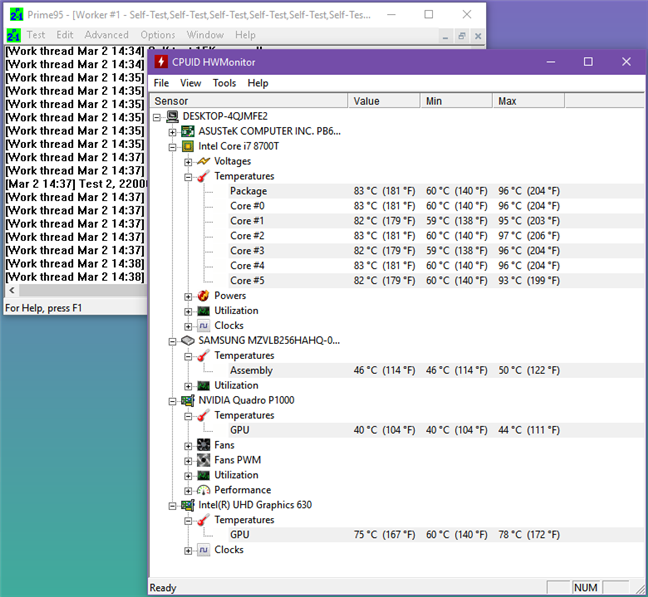

- #PRIME95 PCMARK 10 HOW TO#
- #PRIME95 PCMARK 10 INSTALL#
- #PRIME95 PCMARK 10 DRIVERS#
- #PRIME95 PCMARK 10 UPDATE#
- #PRIME95 PCMARK 10 DRIVER#
To do that, we'll need to download a few essential burn-in utilities: But we want to confirm that our system is totally stable.
#PRIME95 PCMARK 10 DRIVERS#
Now that we have Windows installed, and our platform drivers firmly in place, we know our system is reasonably stable. I downloaded the 650i SLI platform drivers for Windows Vista x86, and the latest 8600 GTS graphics driver. The MSI P6N SLI motherboard we chose is based on the well-regarded NVIDIA 650i SLI chipset, so we have a one stop shop at the NVIDIA drivers page. They're way out of date by the time the motherboard gets from the factory, to the vendor, and then finally to you.
#PRIME95 PCMARK 10 DRIVER#
Remember those driver CDs that came with the motherboard? Throw them right in the trash.
#PRIME95 PCMARK 10 INSTALL#
Trust me on this one.įortunately, our new system completed the Windows install without a hitch. It's tempting to blame Microsoft, but the only possible culprit if you have problems at this stage is the hardware (or possibly a scratched DVD). Here's one thing I've learned from experience: if your system can't finish a clean install of Windows, it's not stable. I placed my OEM copy of Windows Vista into the DVD tray, rebooted, and selected a 120-day trial of Windows Vista Ultimate.
#PRIME95 PCMARK 10 UPDATE#
Others provide programs that allow you to flash the BIOS from within Windows using a friendly GUI.Īt any rate, BIOS update or not, we can now install an operating system. On my ASUS P5B Deluxe, the flash program is embedded into the BIOS.
#PRIME95 PCMARK 10 HOW TO#
A full description of how to flash your motherboard's BIOS is outside the scope of this article, but here's the condensed version: It isn't required, but your life will be easier if you flash to the latest BIOS now before you complete system setup. You'd be surprised how often motherboards ship with out-of-date BIOSes. However, do I recommend flashing the motherboard BIOS to the latest version before you go any further. Beyond those basic settings, mucking around in the BIOS isn't required at this point we want to test the system with stock settings anyway. You'll definitely want to set the boot order to ensure the right drives are booting first- in our case, it's DVD-R, Raptor, then the second drive. For example, I always set the floppy drive to "Disabled". From here you may want to adjust a few basic BIOS settings. Looks good- all three drives are showing up. Go into the basic settings and verify that all the drives we installed are properly detected by the motherboard. During boot, press DELETE to enter the BIOS setup screen. Plug in the power cord, connect a keyboard and mouse, then hit the power switch. As usual I routed the power cable along the back of the motherboard tray to preserve the clean interior layout. I snapped in another modular power connector to provide the necessary 4-pin power. This is not one of those fancy new SATA DVD drives, so we'll need to break out the old-school Parallel ATA cable included with the motherboard. It took a bit of trial and error, but I got the rails screwed into each side of the drive and snapped it in to the top bay. I find rail mounting annoying, but since we're only installing a single DVD-R drive, I can deal. The 5 1/4" drive bays at the top of the P182 require the use of rails, which are provided with the case. I suppose eventually we'll be buying HD-DVD or Blu-Ray drives, but until the format war is decided, it's DVD all the way for me. Fortunately, DVD drives are dirt cheap I chose the latest Lite-On DVD drive, in black to match the case. I snapped a modular SATA power cable into the Corsair HX series power supply, and routed that cable around the back, into the hard drive compartment.īut we can't install an OS without an optical drive. I connected two SATA cables and threaded them down to the bottom channel through the center cutout. I slid them in and secured them using the long screws provided with the case. The secondary drive is a run of the mill 500 GB model. The boot drive is a 10,000 RPM Raptor, which I can't recommend highly enough. After all, they are giant hunks of circular metal spinning at 7,200 to 10,000 RPMs. The bottom cage holds 4 drives, with soft rubber grommets to support each drive, and more importantly, to isolate the case from transmitted, resonant hard drive vibration noise. The Antec P182 case has a well engineered drive mounting system. The first thing we'll need is hard drives. Today, we'll complete the build by installing an operating system and burning it in. We built the system up enough to boot to the BIOS screen successfully. Yesterday, we completed a basic build of Scott Hanselman's computer.


 0 kommentar(er)
0 kommentar(er)
